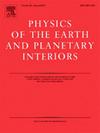秦岭造山带岩石圈复杂变形机制与扬子克拉通地壳顺时针旋转——来自Rayleigh波方位各向异性层析成像的启示
IF 1.9
3区 地球科学
Q2 GEOCHEMISTRY & GEOPHYSICS
引用次数: 0
摘要
秦岭造山带下扬子克拉通与华北克拉通的碰撞辐合导致了复杂的岩石圈变形,其机制尚不清楚。本文采用双站法,从QOB及邻近地区110个地震台站记录的1087次远震事件的垂直分量波形数据中提取了10 ~ 60s的瑞利波频散曲线。随后,利用各向异性层析成像技术重建了QOB及其周围区域地壳和上地幔各向同性和各向异性的高分辨率相速度模型。我们重点分析了QOB的四个关键子区域的变形模式。结果表明,地壳变形受多种地质因素的影响。岛弧碰撞、洋盆闭合、造山活动等主要构造活动从根本上塑造了区域构造格局。在此基础上,地壳岩性特征、逆冲构造运动和断层系统的走向共同控制着当今的变形。此外,我们的各向异性模型结合以往的大地测量和地震观测结果表明,YZC在与NCC辐合期间的顺时针旋转对地壳变形有重要影响。值得注意的是,我们的各向异性模型为YZC地壳的顺时针旋转提供了新的地震证据,这与四川盆地的构造发育和大巴山弧形构造的形成密切相关。结合前人的研究成果,提出了大巴山弧形构造形成机制的概念模型,认为大巴山弧形构造的形成是中-晚三叠世中生代地壳顺时针旋转和中生代与北陆的持续辐合共同作用的结果。这些发现为QOB岩石圈动力学过程提供了新的认识。本文章由计算机程序翻译,如有差异,请以英文原文为准。

Complex deformation mechanisms of the Qinling orogenic belt lithosphere and clockwise rotation of the Yangtze craton crust: Insights from Rayleigh wave azimuthally anisotropic tomography
The collision and convergence between the Yangtze Craton (YZC) and North China Craton (NCC) beneath the Qinling orogenic belt (QOB) have resulted in complex lithospheric deformation, the mechanisms of which remain unclear. In this study, we extracted 10–60 s Rayleigh-wave dispersion curves using the two-station method from vertical-component waveform data of 1087 teleseismic events, recorded at 110 seismic stations across the QOB and adjacent regions. Subsequently, anisotropic tomography was employed to reconstruct high-resolution isotropic and anisotropic phase velocity models of the crust and upper mantle beneath the QOB and surrounding regions. We focused on analyzing deformation patterns in four key subregions of the QOB. Our results demonstrated that crustal deformation is affected by multiple geological factors. Major tectonic activities, such as island arc collisions, oceanic basin closure, and orogenic events, have fundamentally shaped the regional structural framework. Building on this, crustal lithological features, thrust tectonic movements, and the strike of fault systems, which together control present-day deformation. Furthermore, our anisotropic model, in combination with previous geodetic and seismological observations, suggests that the clockwise rotation of the YZC during its convergence with the NCC plays a significant role in influencing crustal deformation. Upper mantle deformation is primarily driven by absolute plate motion, with additional influences from the northeastward escape of material in the Tibetan Plateau and mantle flow. Notably, our anisotropic model provides new seismological evidence supporting the clockwise rotation of the YZC crust, which is closely related to the tectonic development of the Sichuan basin and the formation of the Dabashan arcuate structure. Integrating with previous studies, we propose a conceptual model to explain the formation mechanism of the Dabashan arcuate structure, which we attribute to the combined effects of the clockwise rotation of the YZC crust during the Middle to Late Triassic and the ongoing convergence between the YZC and the NCC. These findings provide new insights into the lithospheric dynamic processes of the QOB.
求助全文
通过发布文献求助,成功后即可免费获取论文全文。
去求助
来源期刊

Physics of the Earth and Planetary Interiors
地学天文-地球化学与地球物理
CiteScore
5.00
自引率
4.30%
发文量
78
审稿时长
18.5 weeks
期刊介绍:
Launched in 1968 to fill the need for an international journal in the field of planetary physics, geodesy and geophysics, Physics of the Earth and Planetary Interiors has now grown to become important reading matter for all geophysicists. It is the only journal to be entirely devoted to the physical and chemical processes of planetary interiors.
Original research papers, review articles, short communications and book reviews are all published on a regular basis; and from time to time special issues of the journal are devoted to the publication of the proceedings of symposia and congresses which the editors feel will be of particular interest to the reader.
 求助内容:
求助内容: 应助结果提醒方式:
应助结果提醒方式:


